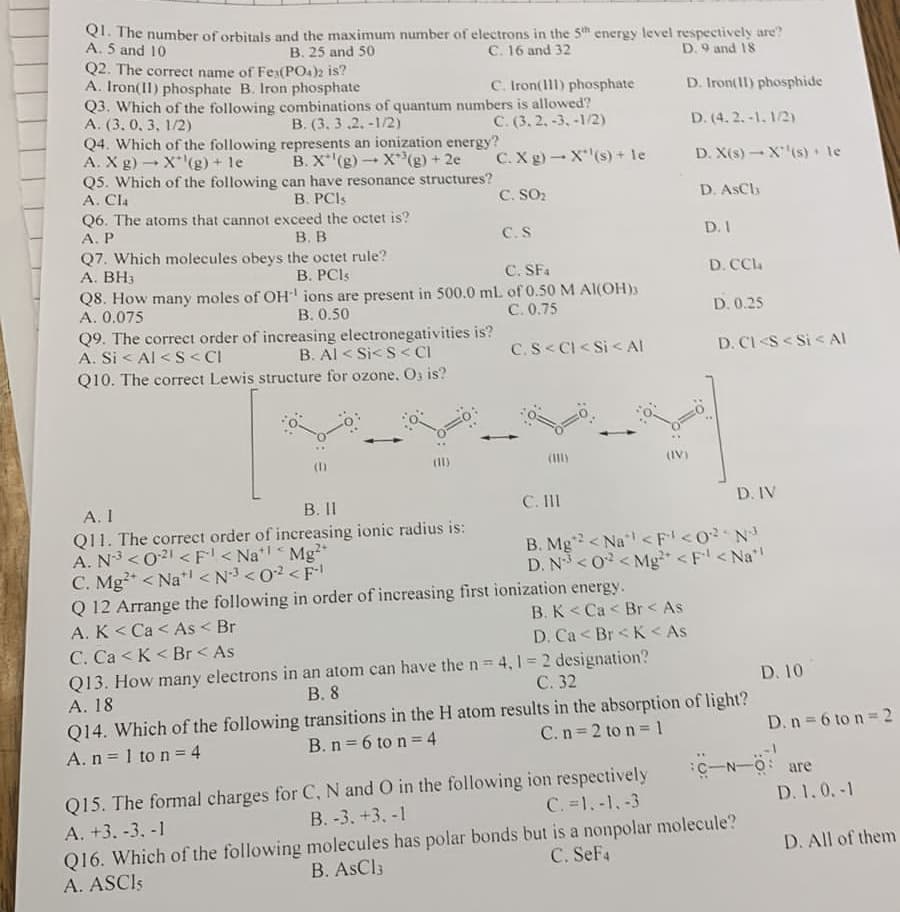Q1. The number of orbitals and the maximum number of electrons in the 5th energy level respectively are? A. 5 and 10 B. 25 and 50 C. 16 and 32 D. 9 and 18
Q1. The number of orbitals and the maximum number of electrons in the 5th energy level respectively are? A. 5 and 10 B. 25 and 50 C. 16 and 32 D. 9 and 18
Chemistry
10th Edition
ISBN:9781305957404
Author:Steven S. Zumdahl, Susan A. Zumdahl, Donald J. DeCoste
Publisher:Steven S. Zumdahl, Susan A. Zumdahl, Donald J. DeCoste
Chapter1: Chemical Foundations
Section: Chapter Questions
Problem 1RQ: Define and explain the differences between the following terms. a. law and theory b. theory and...
Related questions
Question
Q 1 please

Transcribed Image Text:Q1. The number of orbitals and the maximum number of electrons in the 5th energy level respectively are?
A. 5 and 10
B. 25 and 50
C. 16 and 32
D. 9 and 18
D. Iron(11) phosphide
D. (4.2.-1.1/2)
D. X(s)-X¹¹(s) le
D. AsCh
Q2. The correct name of Fes(PO4)2 is?
A. Iron(II) phosphate B. Iron phosphate
C. Iron(111) phosphate
Q3. Which of the following combinations of quantum numbers is allowed?
A. (3.0, 3, 1/2)
C. (3.2, -3, -1/2)
C. X g)
Q4. Which of the following
A. X g) X(g) + le
Q5. Which of the following
A. Cla
C. SO₂
B. (3.3.2.-1/2)
represents an ionization energy?
B. X'(g) X³(g) + 2e
1
can have resonance structures?
B. PCIs
Q6. The atoms that cannot exceed the octet is?
A. P
B. B
Q7. Which molecules obeys the octet rule?
A. BH3
B. PCIs
C. S
Q8. How many moles of OH¹ ions are present in 500.0 ml.
A. 0.075
B. 0.50
Q9. The correct order of increasing electronegativities is?
A. Si< Al <S<CI
B. Al < Si<S<CI
Q10. The correct Lewis structure for ozone. O, is?
A. I
B. 11
Q11. The correct order of increasing ionic radius is:
A. N³ <021 < F< Na¹¹ Mg²+
<
C. Mg2+ < Na <N³ <0² <F-¹
X(s) + le
C. SF4
of 0.50 M Al(OH)3
C.0.75
C.S< Cl< Si< Al
D. I
Q 12 Arrange the following in order of increasing first ionization energy.
A. K< Ca< As < Br
B. K<Ca< Br< As
C. Ca<K< Br< As
D. Ca< Br< K< As
Q13. How many electrons in an atom can have the n = 4,1 = 2 designation?
C. 32
B. 8
A. 18
D. CCla
D. 0.25
D. CI <S<Si < Al
C. III
B. Mg2 <Na <F¹ <0²²N³
D. N³ <02 <Mg²+ <F¹ <Na*
D. IV
Q14. Which of the following transitions in the H atom results in the absorption of light?
A. n = 1 to n = 4
B. n = 6 to n = 4
C. n=2 to n = 1
Q15. The formal charges for
A. +3. -3, -1
C, N and O in the following ion respectively
C. =1.-1.-3
B.-3. +3, -1
Q16. Which of the following molecules has polar bonds but is a nonpolar molecule?
B. AsCl3
A. ASCIS
C. SeF4
D. 10
D. n = 6 to n = 2
C-N-O are
D. 1.0.-1
D. All of them
Expert Solution
This question has been solved!
Explore an expertly crafted, step-by-step solution for a thorough understanding of key concepts.
Step by step
Solved in 2 steps

Knowledge Booster
Learn more about
Need a deep-dive on the concept behind this application? Look no further. Learn more about this topic, chemistry and related others by exploring similar questions and additional content below.Recommended textbooks for you

Chemistry
Chemistry
ISBN:
9781305957404
Author:
Steven S. Zumdahl, Susan A. Zumdahl, Donald J. DeCoste
Publisher:
Cengage Learning

Chemistry
Chemistry
ISBN:
9781259911156
Author:
Raymond Chang Dr., Jason Overby Professor
Publisher:
McGraw-Hill Education

Principles of Instrumental Analysis
Chemistry
ISBN:
9781305577213
Author:
Douglas A. Skoog, F. James Holler, Stanley R. Crouch
Publisher:
Cengage Learning

Chemistry
Chemistry
ISBN:
9781305957404
Author:
Steven S. Zumdahl, Susan A. Zumdahl, Donald J. DeCoste
Publisher:
Cengage Learning

Chemistry
Chemistry
ISBN:
9781259911156
Author:
Raymond Chang Dr., Jason Overby Professor
Publisher:
McGraw-Hill Education

Principles of Instrumental Analysis
Chemistry
ISBN:
9781305577213
Author:
Douglas A. Skoog, F. James Holler, Stanley R. Crouch
Publisher:
Cengage Learning

Organic Chemistry
Chemistry
ISBN:
9780078021558
Author:
Janice Gorzynski Smith Dr.
Publisher:
McGraw-Hill Education

Chemistry: Principles and Reactions
Chemistry
ISBN:
9781305079373
Author:
William L. Masterton, Cecile N. Hurley
Publisher:
Cengage Learning

Elementary Principles of Chemical Processes, Bind…
Chemistry
ISBN:
9781118431221
Author:
Richard M. Felder, Ronald W. Rousseau, Lisa G. Bullard
Publisher:
WILEY